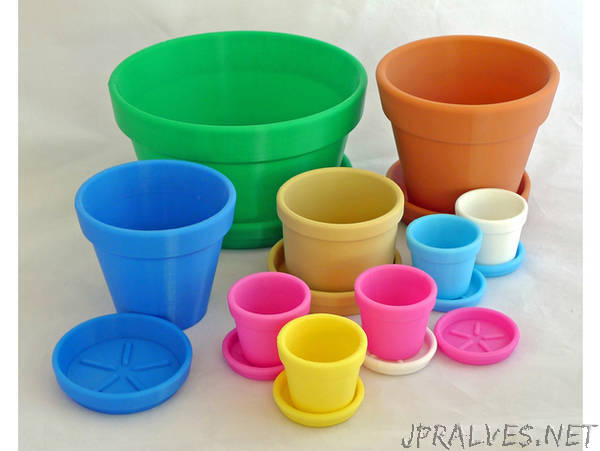
“Spring is coming and there are lots of plants to get started. Here’s a customizable flower pot to help. I’m not sure how well PLA really works as flower pot material (it should be fine), but you don’t have to actually put real plants in them. Plastic plants - that would seem to be rather appropriate. Easter eggs might work, too. Jelly beans would also be a good choice for the smaller ones.
So, why spend time and money printing out something you can easily buy for less than a dollar? That’s the wrong question for those of us on Thingiverse who print tons of often useless stuff.
A better question is why would I spend many hours building a flower pot algorithm in OpenSCAD. Since you asked, I was having fun re-discovering geometry and trigonometry and algebra - stuff I hadn’t used since high school and stuff that most people, at that time in their lives, forget as soon as they can.
On with the flower pot: At the time of this writing, Thingiverse’s Customizer is a little broken in that it won’t display a preview of your model as you change the parameters. While it will still generate a perfect STL file, the lack of preview makes it difficult to judge what settings you need to change in order to get the results you want. The PTB have been notified of the bug, but don’t seem to be able to fix it.
In hopes of helping a little, I’ve uploaded a picture pointing out the parameters you can change and what part of the flower pot they affect.
Some notes on using the Customizer.
While the program tries to limit values to ranges that work well, it’s still possible to produce un-printable results if you color outside the lines, so to speak. For example: the design includes a fillet under the rim of the pot. This is intended to make the pot printable without any supports. It can look really strange and un-pot-like at extreme pot side angles and large rim sizes.
The side and base thickness can be left to the program (set each to ‘0’). The program will set them based, roughly, on the base diameter chosen. However, you can set each dimension manually, if you wish.
If you use all the defaults, you get the pot pictured in the dimensions diagram.
As always, you can download the OpenSCAD code and get around the sanity limits. I’ve tried to comment the heck out of it, but it’s the result of several different design attempts and a lot of iterations to get the calculations correct. It’s not complicated, really. Just a bit messy.
I understand there are other, possibly easier, ways to create a pot. Excellent idea. Make one of your own and post the link here. I’ll probably print it out.
Here’s a brief overview of each parameter you can customize (all dimensions in mm or deg):
Base Diameter: the diameter of the outer edge of the pot’s base. The program limits this to a range: 10-350. When making a saucer, add from 10-20mm to the pot’s diameter to get an appropriately-sized saucer.
Height of Pot: the height of the pot from the base to the top of the rim. The program limits this to a range: 8-350. Hint: a pot’s saucer is just a shorter, wider pot.
Pot SIde Angle: As the included picture shows, this is the number of degrees from vertical. Zero degrees gives a vertical side. The Customizer limits this to a range: 0-30deg in 1-degree increments.
Rim Side Angle: Also, the number of degrees from vertical. The Customizer limits this to a range: 0-30deg. The program also limits this - the rim angle can’t be greater than the Pot Side Angle. It can be less, and actually looks a bit better if it is.
Height of Rim: The rim is the band around the top-edge of the pot. The Customizer limits this to a range: 0-200mm. The program limits the rim height to a bit less than the height of the pot. If you set this to zero, you get a round rim.
Rim Thickness: How thick should the rim be? The program limits this to a range: 0-10mm. Set this to zero to eliminate the rim.
Drain Hole: If you use this to pot plants, or simply for appearance, you can put a drain hole in the bottom of the pot by selecting “Yes.” The diameter of the hole is determined by the program and is based on the pot base’s diameter. If you choose a drain hole, the program ignores the “risers” setting.
Pot Risers: In real life, the pot usually has some feet or something on the bottom to allow the drain to work. To make the pot printable without supports, I had to move the “risers” to the top of the “saucer.” If you want risers, you can’t also have a drain hole. The program determines the dimensions of the risers based on the pot base’s diameter.
Sidewall Thickness: The thickness of the pot’s walls. If you set this to zero, the program will calculate a value based on the pot base’s diameter. You may also set this manually. The program limits this to a range: 1-6mm.
Base Thickness: The thickness of the pot’s base. If you set this to zero, the program will calculate a value based on the pot base’s diameter and it will be a little thicker than the sidewalls. You may also set this manually. The program limits this to a range: 1-7mm.
Final note: the models included with this “thing” are examples and are not necessarily the ones in the photos.”
